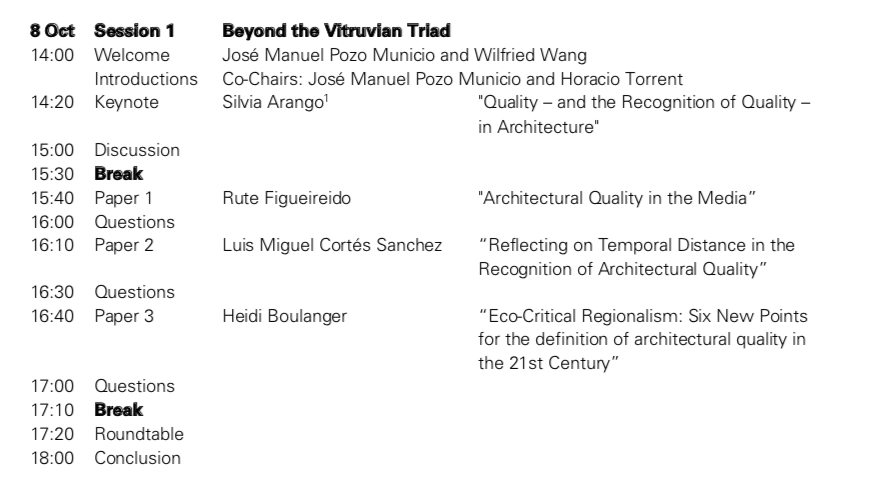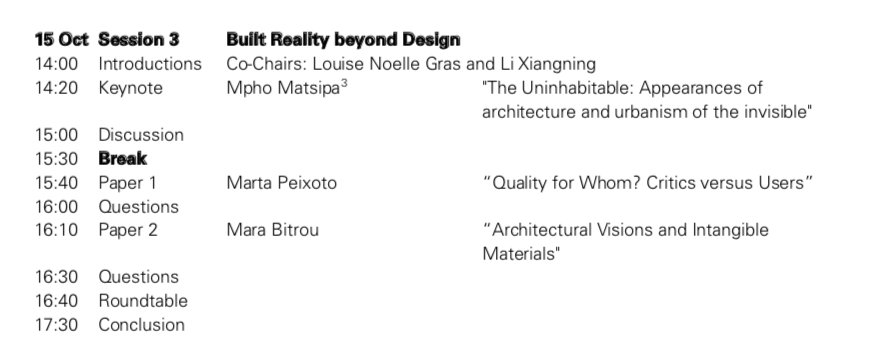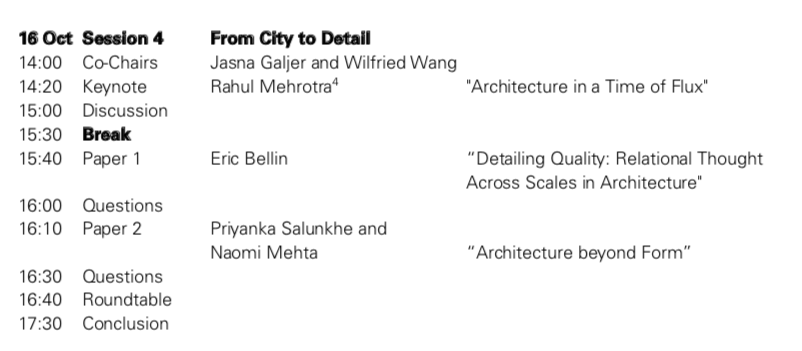Escuela Técnica Superior de Arquitectura Universidad de Navarra, Pamplona, Spain
Co-Organizers José Manuel Pozo Municio and Wilfried Wang
International Conference on Architectural Quality
8 and 9, 15 and 16 October 2022
Defining Architectural Quality
Conference Programme
Each session begins at 14:00 Central European Time
Free access to the Zoom link: https://us06web.zoom.us/j/88039754296?pwd=VGVoTVFJNUljN2xhVTFTVGo4S3R1QT09
Each of the four sessions will be recorded and posted on Youtube.

1 Silvia Arango has been the Professor of History and Theory of Architecture for undergraduates and graduates at the School of Architecture and Urbanism at the National University of Colombia in Bogotá since 1980. Born in Bogotá, Colombia, Silvia Arango received the Diploma of Architect from the University of Andes (Bogotá); Diploma on Urban Design from the Oxford Polytechnic and PhD in Urbanism from the University of Paris XII –Créteil.
Her professional work focuses on the history of Latin American architecture and cities. She has participated in numerous seminars on Latin American Architecture (SAL). In 1992, she received a Guggenheim Fellowship and in 1996 she was awarded a Getty Institute Grant. She has been a visiting professor at the University of Puerto Rico – Rio Piedras (2000), and the Federal University of Rio de Janeiro (UFRJ), Brazil (2003) and was a post-doctoral resident at the Institute of Aesthetic Research at National University of Mexico (UNAM) (2008), as well as a visiting lecturer at numerous institutions.
Select bibliography: History of architecture in Colombia (1989), Story of an itinerary (2002) and City and Architecture. Six Generations that Built Modern Latin America (2012).

2 William J. R. Curtis is an award-winning historian, critic, artist and photographer. Educated at the Courtauld Institute of Art, London (BA 1970) and Harvard University (PhD 1975), he has taught at numerous universities, including Harvard (VES, and GSD), the AA, London, and Cambridge University, where he was Slade Professor of Fine Art.
Curtis’s best-known books are Modern Architecture Since 1900, 3rd ed. 1996 and Le Corbusier: Ideas and Forms, 2nd ed. 2015, both widely translated (French, German, Italian, Spanish, Brazilian-Portuguese, Japanese, Chinese etc.) and referred to as ‘classics’. In charting a diverse modern tradition, he has extended the critical map to evaluate many cultures in the developing world, including the Indian subcontinent, Latin America, North Africa and the Middle East.
Curtis has written numerous books and texts, among them Balkrishna Doshi: an Architecture for India; Denys Lasdun: Architecture, City, Landscape; Teodoro Gonzalez de Leon, Obra Reunida; Juha Leiviska: Space, Light, Music; he has also published seminal articles in the Journal of the Society of Architectural Historians and the Times Literary Supplement. Curtis is an engaged critic who has sat on international juries and who contributes regularly to journals such as the Architectural Review, Architectural Record, Arquitectura Viva, D’Architectures, A+D (India), A+U (Japan), Il Giornale dell’architettura and ARK. He has taken political and polemical stands in newspapers such as El Païs, La Vanguardia, Le Monde, the Indian
Express. Curtis has written more than twenty monographic texts in the Spanish review El Croquis, on architects such as Rafael Moneo, Alvaro Siza, Juan Navarro Baldeweg, Herzog & de Meuron, Tadao Ando and RCR Aranda Pigem Vilalta.
He has also exhibited and published his art-work and photographs internationally. In 2015, a retrospective exhibition Abstraccion y Luz / Abstraction and Light: Paintings, Drawings, Photographs by William J.R. Curtis was installed in the Palace of Carlos V of the Alhambra accompanied by book of the same title with a preface by Alvaro Siza.
Among Curtis’s awards: The Alice Davis Hitchcock Medallion, Society of Architectural Historians of Great Britain, 1984; Critic’s Award Comité International des Critiques d’Architecture (CICA), 1985; the 1999 Gold Medal of the Tau Sigma Delta Honor Society in Architecture and Allied Arts (USA); a 50 year Commemoration Medal from the Museum of Finnish Architecture, 2006; the 2014 Golden Award for Global Contribution to Architecture (India); CICA Bruno Zevi Book Award, Citation for Excellence, 2016; Médaille de l’Académie d’Architecture 2022.

3 Mpho Matsipa is an educator, researcher, and curator o. Mpho was a Loeb Fellow ’22 at the Graduate School of Design, Harvard University, and a Chancellor’s Fellow at the University of the Witwatersrand, South Africa in 2021-2022. She received her PhD in Architecture from UC Berkeley.
She has delivered talks globally and taught Advanced Studio, History and Theory of Planning and Architecture in the School of Architecture and Planning at the University of the Witwatersrand, The Cooper Union for Art and Science and Columbia University.
She was a co-investigator on an Andrew Mellon research grant on Mobilities, has written critical essays on art and architecture and curated several exhibitions and discursive platforms including the 14th International Architecture Exhibitions at the Venice Biennale (2008; 2021); chief curator of African Mobilities at the Architecture Museum, Pinakothek der Moderne in Munich (2018); and Studio-X Johannesburg, in South Africa (2014-2016).
Mpho is currently an associate curator for the Lubumbashi Biennale (2022) and working on a publication project on African Mobilities.

4 Rahul Mehrotra is the principal founder of RMA Architects. He divides his time between working in Mumbai and teaching at the Graduate School of Design at Harvard University, Boston, where he is Professor of Urban Design and Planning and the John T. Dunlop Professor in Housing and Urbanization.
His Mumbai-based firm, RMA Architects, was founded in 1990. The firm has designed a software campus for Hewlett Packard in Bangalore, a campus for Magic Bus (an NGO that works with poor children), led the restoration of the Chowmahalla Palace in Hyderabad, and formulated a conservation master plan for the Taj Mahal with the Taj Mahal Conservation Collaborative. The firm also recently designed and built a social housing project for 100 elephants and their caretakers in Jaipur. In 2015 RMA Architects completed the Lab of the Future on the Novartis Campus in Basel, Switzerland and were finalist in an international design competition for the Museum of Modern Art in Sydney. Recent projects of the firm include a Library for the School of Architecture at CEPT, the Faculty of Arts and Sciences at Ahmedabad University, and a School of Public Policy at the IIM Ahmedabad. In 2018 RMA Architects were awarded the Venice Biennale Juror’s Special Mention for “three projects that address issues of Intimacy and empathy, gently diffusing social boundaries and hierarchies.”
His writings include co-authoring Bombay: The Cities Within, which covers the city’s urban history from the 1600s to 1990 and Bombay to Mumbai: Changing Perspectives; and Taj Mahal : Multiple Narratives. He has also co-authored Conserving an Image Center: The Fort Precinct in Bombay. Based on this study and its recommendations, the historic Fort District in Mumbai was declared a conservation precinct in 1995, a first such designation in India. In 2011, Mehrotra wrote Architecture in India–Since 1990, a reading of contemporary architecture in India that was extended into a 2016 exhibition he co-curated at the National Gallery of Modern Art in Mumbai titled The State of Architecture: Practices and Processes in India. In 2012–2015, he led a Harvard University-wide research book project
called The Kumbh Mela: Mapping the Ephemeral Mega City. This was followed in 2018 by a co-curated exhibition titled The State of Housing: Realities, Aspirations and imaginaries in India, which is currently travelling in India.
Mehrotra’s most recent books are Working in Mumbai (2020) and The Kinetic City and other essays (2021). The former a reflection on his practice evolved through its association with the city of Bombay/Mumbai. The second book presents Mehrotra’s writings over the last thirty years and illustrates his long-term engagement with and analysis of urbanism in India. This work has given rise to a new conceptualization of the city, which Mehrotra calls the Kinetic City.
Please feel free to download the programme in PDF format below.

0 comments on “International Conference on Architectural Quality”